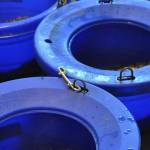Supplementing Trace Minerals in Horse Rations

Trace minerals—those needed in only small amounts for proper nutrition—can be supplied in either a mineral supplement or a premixed feed. Always consult the label to determine the contents before supplementing, and compare products or ask an equine nutritionist for advice.
Iron
Iron is the trace mineral most often associated with exercise, even though its actual relevance is questionable. The concern with iron stems from its well-known function as part of the heme molecule that carries oxygen in the blood. The first symptom associated with iron deficiency is anaemia, specifically a hypochromic, microcytic anaemia. In practice, there are few instances when the diet would result in iron deficiency anaemia.
Clinically significant anaemia in the horse is rare. Exceptions are horses with severe burdens of intestinal parasites, horses with gastric ulcers that lead to blood loss, and perhaps horses suffering from severe exercise-induced pulmonary hemorrhage (EIPH). The suggested iron requirement of a 500-kg horse is 500, 600 and 1200 mg/day for light, moderate and heavy exercise, respectively.
Manganese
Manganese is involved in bone formation, oxidative phosphorylation in the mitochondria of the cell, fatty acid synthesis, and amino acid metabolism either as a coenzyme or as an activator of enzymes. There is very little (<0.2 mg/L) manganese lost in horse sweat, and horses at low levels of exercise require approximately 350 mg/day, whereas those in moderate to high work intensities would require 500 mg/day in the diet. Manganese deficiency is most likely when excess calcium and phosphorus in the diet interfere with its absorption.
Selenium
Strenuous exercise is known to induce oxidative stress, leading to the generation of free radicals. This may induce lipid peroxidation and tissue damage in both the respiratory system and working muscle tissue, particularly if the horse is deficient in vitamin E and/or selenium (antioxidants and scavengers of free radicals).
Selenium deficiency is related to the soil content of selenium and the subsequent effect on pasture, hay, and grain. Selenium-deficient soils occur in certain parts of Australia and New Zealand. Dietary deficiency can be identified by blood-testing the horses on your property.
The selenium requirement for mature horses at rest has been estimated by the National Research Council to be 0.1 mg/kg (NRC, 2007), based on studies that evaluated the relationship between selenium intake and blood selenium. Other authorities have suggested that the appropriate concentration of selenium in the total diet of a horse is 0.3 mg/kg. Therefore, if a concentrate mix comprises 50% of the diet and the forage component of the diet supplies 0.06 mg/kg of selenium, the grain mix would need to supply approximately 0.6 mg/kg. Before supplementing selenium, contact your local agricultural consultant to check the selenium content of the soils in your local area.
Iodine
Iodine is part of the thyroid hormones thyroxin and triiodothyronine. A deficiency or toxicity of iodine may result in goitre (an enlarged thyroid gland). In the performance horse, the most important role of thyroxin is controlling metabolism. The thyroid hormones stimulate the mitochondria in the cell to increase their oxygen consumption and thus their energy production. Performance horses in light work require 1.75 mg/day of iodine, in moderate work 2.5 mg/day, and in intense training 2.75-3.0 mg/day. Iodine toxicity from overfeeding seaweed meal is more common than iodine deficiency.
Chromium
Chromium is a component of glucose tolerance factor, which is thought to potentiate the action of insulin in chromium-deficient tissue. Insulin promotes glucose uptake by the cell, stimulates amino acid synthesis, and inhibits tissue lipase. In athletic humans, chromium excretion is increased and the chromium requirement is increased by physical activity; therefore, a similar situation probably occurs in performance horses.
Copper
Copper is essential for several enzymes involved in the synthesis and maintenance of elastic tissue, mobilization of iron stores, preservation of the integrity of the mitochondria, and detoxification of superoxides. There is a small loss of copper in the sweat of horses (approximately 4 mg/L), and performance horses in light, moderate, and heavy work require approximately 130, 170, and 190 mg/day of copper, respectively. Approximately 50-75 mg/day will be supplied by pasture or alternative forage sources, depending on their quality.
Zinc
Zinc is involved as a cofactor in many enzyme systems. A small amount of zinc is lost in sweat (20-21 mg/L). Performance horses require about 400 mg/day during light work and 500 mg/day during moderate and heavy exercise.
Most commercial feeds contain proper amounts and ratios of trace minerals for the horses for which the feeds have been designed. Before adding mineral supplements of any kind, have your feed analyzed for mineral content and seek the advice of an equine nutritionist.








